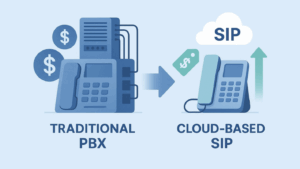
SIP Trunk Lines: Revolutionize Your Communication
The way businesses handle communication is evolving fast, and the tools you choose can make or break your ability to scale. SIP trunk lines are leading the shift from traditional phone systems to modern, internet-based solutions, offering more than just a way to make calls. They bring flexibility, cost savings, and the reliability that growing businesses need to stay connected and competitive.
If you’ve ever wondered, “What is a SIP trunk line, and why does it matter?” you’re not alone. With the global VoIP market projected to hit $263 billion by 2032, more organizations are looking into SIP trunking services as the backbone of their communication strategy. This guide breaks down how SIP trunk lines work, the key benefits of SIP trunking, and how to make a smooth transition from traditional phone lines to smarter, more scalable solutions.
Understanding SIP Trunk Lines
SIP trunk lines are a foundational part of modern communication systems, replacing traditional phone lines with a more flexible and scalable internet-based solution. As businesses prioritize digital transformation, understanding how SIP trunk lines work and how they differ from older analog systems is essential for building a reliable, cost-effective communications system that supports future growth and keeps pace with rising data traffic demands.
Session Initiation Protocol (SIP)
Session Initiation Protocol is the signaling technology behind SIP trunk lines. It initiates, maintains, and terminates communication sessions over the internet. Whether it’s a voice call, video conferencing session, or instant message, SIP handles the setup and teardown of each interaction. As a key component of internet telephony service providers, SIP ensures seamless connectivity across diverse communication channels, making it the backbone of modern business phone systems.
Voice over Internet Protocol (VoIP)
Voice over Internet Protocol enables voice calls to travel over a broadband internet connection instead of traditional phone lines. When combined with SIP, VoIP becomes part of a powerful communication system that replaces outdated physical phone lines. With VoIP, your business can transmit voice traffic as digital data packets, optimizing both call quality and bandwidth use. Businesses often choose an internet backbone for their communication systems to reduce costs and improve network efficiency.
Digital Internet Trunk Lines vs. Analog Traditional Phone Lines
Traditional phone lines rely on physical copper wiring and are limited in scalability and features. In contrast, digital SIP trunk lines use your internet connection to transmit voice, video, and data, eliminating the need for physical infrastructure upgrades.
Analog phone lines are tied to a single location, while SIP trunks provide virtual connection points that support remote work, multiple office locations, and higher call volumes. Businesses transitioning from analog to digital trunk lines benefit from improved network management, cost control, and operational flexibility.
How It All Comes Together
SIP trunk lines connect your business phone system to the public switched telephone network (PSTN) using your existing internet access. This eliminates the need for multiple physical phone lines and enables a more scalable approach to communication. With SIP trunking, you can support as many concurrent calls as needed simply by adjusting your SIP channels.
Concurrent Calls: SIP trunking allows multiple inbound and outbound calling sessions at the same time. Each SIP channel represents a single call, and businesses can easily add more channels to accommodate higher call volume without adding new hardware.
Virtual Lines: Instead of relying on physical infrastructure, SIP lines exist in software. This makes it easy to scale up or down, route traffic intelligently, and support hybrid or fully remote teams—all while maintaining clear, high-quality voice calls.
The Benefits of SIP Trunking for Your Business
Businesses are rethinking how they connect calls, manage data traffic, and stay flexible. SIP trunking offers a future-ready solution by replacing traditional phone lines with virtual connections that are faster, more scalable, and more cost-effective.
From supporting remote teams to managing high volumes of inbound and outbound calling, SIP trunk lines simplify network infrastructure while enhancing performance. Below are some of the most impactful benefits of SIP trunking and why it’s becoming a critical component of any modern communications system.
Cut Costs by Replacing Outdated Phone Lines
One of the most immediate advantages of SIP trunking is the significant cost reduction. Traditional phone systems often require separate lines for each user or department, plus added fees for long-distance or international calls. SIP trunk lines simplify your communications setup by using your existing internet connection to manage inbound and outbound calling. You can reduce the need for multiple physical phone lines and eliminate unnecessary infrastructure expenses, helping you manage call volume more efficiently without inflating your budget.
Scale Your Communication System as You Grow
Unlike traditional phone systems, which require manual installations and equipment upgrades, SIP trunking allows your business to scale instantly. Need more SIP channels to support concurrent calls during a seasonal spike or expansion? Simply add them through your control panel. No waiting on hardware or tech teams. Having flexibility in network access ensures that your communication channels always match your current business needs.
Build a Flexible, Future-Ready Communications System
In addition to supporting voice calls, SIP trunk lines unify your communication by enabling voice, video conferencing, and messaging through a single connection. With support for VoIP technology and integration across devices and platforms, businesses can eliminate siloed systems and streamline operations. Whether you’re connecting remote teams, setting up new locations, or upgrading a legacy phone system, SIP trunking provides the adaptability to work anywhere internet access is available.
Ensure Business Continuity with Built-In Reliability
A strong communications system needs to be dependable, no matter the conditions. SIP trunking enhances reliability through features like automatic failover routing and redundancy, ensuring that calls can be rerouted if a connection drops. Without the vulnerabilities of physical phone lines, such as weather damage or local outages, SIP services offer more consistent uptime and clearer voice quality across your telephone network.
How SIP Trunk Lines Work
SIP trunk lines create a virtual connection between your business’s private branch exchange (PBX) and the telephone network, using Session Initiation Protocol to manage voice traffic and other communication sessions. Instead of relying on a physical link like analog or PRI lines, SIP trunking converts voice into digital data packets, which are then routed over your existing internet connection.
What sets this approach apart is how it centralizes your communication channels—voice, video, and messaging—into a unified system that can be managed from one place. With SIP trunking, businesses gain more control over network traffic and call routing while making better use of existing network resources. The benefits of SIP trunking lead to smarter network management, simplified scaling, and greater flexibility across locations.
SIP Channels vs. SIP Lines
While often used interchangeably, SIP channels and SIP lines refer to two distinct components within a SIP trunking service. Understanding the difference is key to effective network planning.
A SIP channel is the capacity to handle a single phone call, whether inbound or outbound, over your SIP trunk. If your business regularly makes or receives multiple phone calls at once, you’ll need one channel for each concurrent call. For example, if you need to support up to 20 simultaneous calls, you’ll need 20 SIP channels.
On the other hand, a SIP trunk line acts as the virtual connection between your business phone system and the PSTN. Each SIP trunk can support multiple channels, depending on your bandwidth and service plan. By customizing your channel count, you can manage call volume efficiently without investing in physical phone lines or additional PRI trunks.
Businesses gain control over how voice traffic moves across their data networks, supporting both cost efficiency and future growth. As a result, SIP trunking becomes a core tool for managing network resources and optimizing communication sessions.
The Role of SIP Providers
A SIP provider supplies the infrastructure and services needed to connect your SIP trunk lines to the broader telephone network. They handle the routing of voice traffic, manage call authentication, and ensure secure, reliable transmission of data packets over the internet. The quality of service you receive, such as voice clarity, uptime, and latency, largely depends on the provider’s network backbone and how they manage data traffic.
In addition to call delivery, SIP providers often offer tools for network management, number provisioning, security protocols, and real-time call analytics. These features enable businesses to monitor performance, scale channels on demand, and respond quickly to any disruptions. Choosing a provider with a robust and redundant infrastructure is key to maintaining consistent voice service and supporting future growth without compromising reliability.
Implementing SIP Trunk Lines in Your Business
Adopting SIP trunk lines can streamline your communications infrastructure, but a smooth implementation depends on choosing the right service provider and ensuring your setup is optimized for performance. Here are the key areas to consider before making the switch:
- PBX Compatibility
Make sure your existing PBX system supports SIP or can be connected via an analog telephone adapter (ATA). Most modern PBX systems include Ethernet ports or SIP functionality, but legacy systems may need a gateway to enable SIP trunking. - Reliable Internet Bandwidth
Since SIP trunking runs over your internet connection, your bandwidth must support your expected call volume. Each SIP channel typically requires around 85 kbps in both directions. Insufficient bandwidth can lead to dropped or choppy voice calls, especially when competing with other types of network traffic. It’s also important to work with reliable internet service providers that can deliver consistent performance and low latency for voice traffic. - Quality of Service (QoS)
Your backbone network should be configured to prioritize voice traffic over other data. QoS settings ensure clear voice calls even when your internet connection is under heavy use, like when large files are being downloaded or video streams are active. - Security and Fraud Protection
Even with dedicated internet access, safety is a top priority. Look for providers that offer robust security protocols, including encryption and fraud detection. Real-time monitoring of unusual calling patterns, secure SIP authentication, and automatic blocking of suspicious activity help safeguard your voice traffic and sensitive data. - Scalable Number and Channel Management
Choose a provider with intuitive tools for managing SIP channels and phone numbers. Whether you’re porting existing numbers or provisioning new ones, the process should be straightforward. Scalable management tools also let you adjust your setup as your call volume or business needs evolve. - Real-Time Call Data and Insights
Access to detailed call data records (CDRs) in real time can help you monitor usage, troubleshoot issues, and forecast future needs. Analytics are essential for optimizing your communications system and managing costs effectively.
By evaluating these areas, your business can confidently implement SIP trunk lines that enhance connectivity, reduce operating costs, and support long-term growth. A thoughtful rollout today sets the stage for a more agile and efficient communication system tomorrow.
Future-Proof Your Business Communication with SIP Trunk Lines
SIP trunk lines are a long-term solution for businesses that need reliable, scalable, and cost-efficient communications. By shifting from traditional phone systems to virtual trunk lines, you gain more control over your call volume, simplify your network infrastructure, and position your team to stay connected wherever work happens.
At SIP.US, we make it easy to take that next step. With flexible service options, instant provisioning, and a fully automated control panel, we give you the tools to manage your phone system on your terms. Whether you’re ready to scale or simply want a smarter way to route calls, we’re here to help. Get started today and discover how SIP trunking can transform the way your business communicates.



